SmartRent, Inc. (NYSE:SMRT) Q3 2023 Earnings Call Transcript November 7, 2023
SmartRent, Inc. beats earnings expectations. Reported EPS is $-0.04, expectations were $-0.05.
Operator: Hello, and welcome to smartrent.com Inc. Conference Call. Please note that this call is being recorded. I’d now like to hand over to the first speaker for today, Brian Ruttenbur. Please go ahead.
Brian Ruttenbur: Hello, and thank you for joining us today. My name is Brian Ruttenbur, Senior Vice President of Investor Relations for SmartRent. I’m joined today by Lucas Haldeman, Chairman and CEO; and Hiroshi Okamoto, Chief Financial Officer. They will be taking you through our results for the third quarter of 2023, as well as discussing guidance for the fourth quarter of the year. Before today’s market opened, we issued an earnings release and filed our 10-Q for the three months ended September 30, 2023 both of which are available on the Investor Relations section of our website, smartrent.com. Before I turn the call over to Lucas, I’d like to remind everybody that the discussion today may contain forward-looking statements that involve risks and uncertainties.
Various factors could cause our actual results to be materially different from any future results expressed or implied by such statements. These factors are discussed in our SEC filings, including our annual report on Form 10-K and our quarterly report on Form 10-Q. We undertake no obligation to provide updates with regard to the forward-looking statements made during this call, and we recommend that all investors review these reports thoroughly before taking a financial position in SmartRent. During today’s call, we will refer to certain non-GAAP financial measures. A discussion of these non-GAAP financial measures along with the reconciliation to the most directly comparable GAAP measure is included in today’s earnings release. We would also like to highlight that the third quarter earnings deck is available on the Investor Relations section of the website.
And with that, let me turn the call over to Lucas to review our results.
Lucas Haldeman: Good morning. Thank you for joining our call. We reported a strong first nine months of 2023, marked by nearly 40% improvement in revenue and a decrease in our operating losses by more than $40 million. In the third quarter, we delivered both revenue and adjusted EBITDA within our guidance range. We grew total revenue by 22% year-over-year to more than $58 million and we improved adjusted EBITDA to negative $5 million, an increase of approximately $1.5 million sequentially and $12.6 million from the third quarter of 2022. This quarter marks our sixth consecutive quarter of improved adjusted EBITDA, primarily driven by higher gross margin. In the third quarter, we increased bookings from second quarter levels by 57% to more than $49 million.
We also expanded overall gross margin by nearly five percentage points from the second quarter to more than 23% and from 2.5% last year. Hardware and hosted services gross margin hit record highs. We increased our cash position by $14 million. We believe that we will achieve sustainable positive cash flow from operations within six months after reaching profitability on an adjusted EBITDA basis. SmartRent continues to lead in innovation, creating new products that pave the way for the next generation of smarter living and working in rental housing. This quarter, I’m pleased to share that we’re launching a product that has been years in the making. We are bringing our Hub+ [ph] device to rental housing, the latest best-in-class solution that we have built from the ground up.
It’s sleek, it’s modern, it’s smart. It’s the next level of smart technology for our customers and combines the power of our Smart Home hub at a smart thermostat into one single device. It’s less hardware to install and offers all the benefits of our other hubs and thermostats. It powers remote capabilities, simplified automation and more efficient operations. It’s a product we are proud to bring to market and are encouraged by the positive feedback we’re hearing from our customers. We are beginning to deploy the Hub+ and anticipate that we will see more meaningful results and revenue contribution in 2024. We are also moving forward with integrating new artificial intelligence applications into our products. The strategic application of AI is growing in importance for streamlining operations and rental housing.
One example of how SmartRent is introducing AI to our solutions is a new feature in our work management product called Walk and Talk. This AI-powered feature enables users to use natural language to describe tasks that need to be completed, like any unit repairs, and automatically creates and assigns work orders. Walk and Talk saves site teams valuable time empowering them to easily categorize and complete day-to-day tasks. SmartRent data shows that when utilizing Walk and Talk, maintenance technicians can create a work order 70% faster. The efficiencies realized from automating countless tasks result in hours and dollars saved while also contributing to higher team satisfaction. We continue to lead the industry by innovating new hardware and software solutions for the rental housing market.
We are pleased with our results and our strengthening balance sheet. We remain on track to achieve adjusted EBITDA profitability by the end of the year and cash flow breakeven within the following six months. I will now turn the call over to Hiroshi to review the financials in more detail.

Hiroshi Okamoto: Thank you, Lucas. Q3 marked a quarter of internal changes in operational improvements to reposition the company for sustainable future profitability and growth. Amidst this backdrop of changes it was a quarter of solid revenue expanding margins and narrowing adjusted EBITDA loss. As Lucas reiterated, we are on track to become adjusted EBITDA positive in Q4. In discussing the highlights for the quarter, I will group my points into the following categories: first, revenue and bookings growth; second, operational improvements and margin expansion; and third, profitability and cash optimization. Total revenue for the quarter was $58.1 million, up 9% from Q2 and 22% from Q3 of last year. This was the second highest quarter for revenue in the company’s history following Q1 of this year.
The first three quarters of the year totaled $177 million, up 39% from $127 million for the first three quarters of 2022, and already surpassing our total fiscal 2022 revenue of $168 million. By revenue stream hardware revenue was $35.6 million. Professional services was $6 million, and hosted services was $16.5 million. The composition of our revenue continues to evolve as our expanded product line is being adopted by our customers. ARPU for hardware continues on an upward trajectory of 8% year-over-year. Professional services ARPU increased 32% year-over-year. SaaS ARR increased from $39 million in Q2 to $43 million in Q3, as we topped $10 million in quarterly SaaS revenue for the first time. This was an increase of 12% sequentially and a 35% increase year-over-year.
Total deployed units increased to 683,000 with 32,000 units being deployed this quarter. Bookings for the quarter were $49.7 million and 46,000 units up 57% and 132% respectively from the previous quarter. Although, we expect bookings to continue to be nonlinear from quarter-to-quarter, we are encouraged not only by the increases in bookings and booked units this quarter but by bookings ARR ARPU being above $8 for the second quarter in a row. This demonstrates how our efforts to cross-sell and upsell the suite of products are starting to flow through to our performance metrics. Operational improvements continued to drive gross margin expansion for hardware and hosted services. Total gross profit was $13.5 million, compared to $10 million last quarter and $1 million a year ago.
Hardware margin increased to 23%, up from 21% last quarter, and 5% a year ago and in absolute dollars contributed $8.1 million. Efficiencies in manufacturing, logistics and distribution continue to drive expanded margins in hardware. Hosted services contributed $10.6 million of gross profit compared to $10 million last quarter and $7 million a year ago. Hosted services margin increased to 64%, up from 63% last quarter and 51% a year ago. SaaS margins a part of hosted services held steady at 74%, an increase from 57% a year ago. Professional services gross margin declined in Q3 due to lower deployment volumes. However, I want to highlight that we have continued to invest in technology initiatives over the past several quarters to allow our teams to be more efficient with installations and further our collaboration with trusted partners to augment our teams.
The operational improvements we have implemented transforms our professional services to a more variable cost model. As we evolve the model toward generating a positive margin, we believe that we will have improved professional services margin in Q4 with continued improvement throughout 2024. Adjusted EBITDA for the quarter was negative $5 million, an improvement of 22% from Q2 of negative $6.4 million. Total operating expenses was $23.5 million, a decrease of 16% from $27.8 million a year ago and an incremental increase from $22 million in Q2, as we continue to grow our operations. The significant changes we made to our operating model in the pursuit of efficiency gains in optimizing processes is what will allow us to scale for long-term growth and profitability.
In addition to our focus on operational profitability, getting the business to generate cash has been equally important. Our cash balance increased to $211 million from approximately $197 million at the end of Q2, an increase of about $14 million. The increase in cash this quarter is not a result of the ADI arrangement, but is primarily due to improved inventory management and demand forecasting to reduce our inventory levels as we gradually transition to ADI over the next year. We continue to have no debt maintain an undrawn credit facility of $75 million and we reiterate that we expect to be free cash flow positive from operations in the first half of next year. Guidance for Q4 and full year 2023 are as follows. We are narrowing Q4 guidance for revenue to $58 million to $63 million from $58 million to $70 million.
We are reiterating adjusted EBITDA to be breakeven to positive $2 million for the quarter. Accordingly, we are narrowing full year guidance for revenue to $235 million to $240 million from $233 million to $250 million. We are narrowing adjusted EBITDA toward the higher end of the range to negative $20 million to negative $18 million from negative $22 million to negative $18 million. I will now pass the call back to Lucas for closing remarks.
Lucas Haldeman: Thank you, Hiroshi. In the latter half of 2023, we have remained focused on optimizing our operations to become adjusted EBITDA positive. Improvements in gross margin and tight control of operating expenses led to improved profitability with adjusted EBITDA hitting a quarterly record since becoming a public company. We implemented technology initiatives and further augmented our implementation team with trusted partners to transform our professional services to more of a variable cost model, which we believe will improve our professional services margin in Q4 and into 2024. We have a strong balance sheet and cash position and have clear visibility on cash flow in the near term. We will continue to evaluate our best uses of cash moving forward.
Our IoT solutions are now deployed in more than 680,000 rental units. The total addressable opportunity in rental housing in the US stands at more than 40 million units, offering ample room for growth. Each quarter, we penetrate more of the market by anticipating and responding to the needs our customers share with us. Our customers are generating strong returns from our solutions through enhancing their operations, protecting assets, generating revenues, and improving the quality of living and working in their communities. As I shared earlier in our call, innovation is a cornerstone of our approach. We create, invest in, and deploy offerings that add unparalleled value for our clients. It remains important for us to pursue both SaaS and hardware opportunities as our customers demand and benefit from the integration of Volt Solutions.
Our powerful combination of our hardware and software products has allowed us to scale and lead the proptech industry. The ROI of our platform provides our customers ongoing incentive to roll out our solutions as property owners seek to optimize business operations. From protecting assets with our leak sensor technology to creating connected communities with community Wi-Fi to automating workflows and tasks for site teams, our intentionally designed solutions power a better world and make living and working easier for all. Operator, please open the call for questions.
See also Dividend Aristocrats Ranked: Top 15 According to Analysts and 15 Most Valuable Pre-IPO Companies in The World.
Q&A Session
Follow Stein Mart Inc (NASDAQ:SMRT)
Follow Stein Mart Inc (NASDAQ:SMRT)
Operator: [Operator Instructions] Our first question comes from Nikhil Vijay from KBW. Your line is now open.
Nikhil Vijay: Hi, this is Nikhil Vijay on for Ryan Tomasello. Thank you for taking my questions. I have two for you. First, can you provide more color around what you are seeing in terms of macro and apartment end market conditions? Just curious how have customer conversations and overall demand being trending in light of the headwinds that the apartment operators been facing. And secondly have you seen any changes in the M&A landscape in terms of the deal flow and valuations? And is that something you would still consider at the right price and strategic fit?
Lucas Haldeman: Thanks Nikhil. I’ll take both of those. First, on the macro environment, I think we’re definitely seeing a softening rent environment. We saw that from the latest public reports. It actually continues to be a tailwind for us as owners and managers are really focused on reducing expenses and driving ancillary revenue, something that our platform does both of those things. And so while we are seeing some softening in the market around rents, it’s not hurting our demand at all. And then in terms of changes in the M&A environment, we continue to look as things come to market. We have not seen anything that we believe is an opportunity we should pursue at the moment, but always looking and I think certainly as you see us move from adjusted EBITDA positive to free cash flow, I think that will open up some of the cash on the balance sheet to look at those opportunities.
So, nothing to guide you to Nikhil, but feeling good about where the market is. And I do think we’re starting to see private company valuations come into line. Thanks for the question.
Nikhil Vijay: Thank you.
Operator: Our next question comes from Erik Woodring from Morgan Stanley. Your line is now open.
Erik Woodring: Awesome. Good morning guys. Thank you very much for taking my questions. I’m going to try to sneak in three if I can. The first one maybe for you Lucas is just kind of bigger picture. Your unit deployments have trended lower in the last two quarters. I know that you are trying to kind of balance profitability and growth, but with you guiding down full year revenue slightly this quarter it’s a little hard to parse out what of this kind of deployment slowdown is maybe intentional versus a product of the environment and demand from your customers. So is there any additional color that you can share with us? So just kind of help us gain comfort in the longevity of the different headwinds you’re seeing to deployments especially about when we think about deployments maybe getting back to growth. What we need to see to unlock that growth lever? Just a little more color would be very helpful. Thank you.
Lucas Haldeman: Sure. Thanks for the question, Erik. I think last year at this time I think it was the quarterly call this year we really tried to signal to investors and to the analyst community that we’re diverging from the primary KPI of this business being new units and that we’re really focused on growing revenue, but more importantly getting to profitability and so that means growing profitable revenue. And so what you’ve seen is we’re — that is the focus. We’re focused on where is the ability to grow profitable revenue. It’s not just about achieving top-line results. So where I kind of guide you to Erik is — it really we are looking to go to the higher end range of the adjusted EBITDA positive and what that means is slightly less total revenue.
But ultimately what we feel like and what we’ve heard from the investment community is that getting that profitability and maintaining that is more important than achieving top-line results. So I think what you’re seeing in terms of new unit deployment is completely intentional as we’re really working to get to free cash flow positive.


